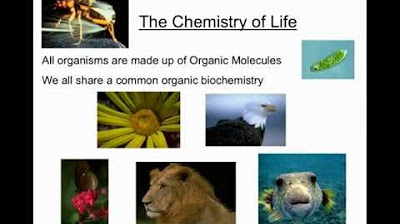Physical and Chemical Properties of Matter
Summary
TLDRIn this chemistry lesson, Mr. Cazy explores the properties of matter, distinguishing between physical and chemical properties and changes. Physical properties are characteristics that can be observed without altering the substance, like mass and color. Chemical properties, however, involve a transformation resulting in new substances, such as combustion. Examples of physical changes include tearing paper or dissolving sugar, while chemical changes are illustrated by burning paper, which produces ash and carbon dioxide. Understanding these concepts is crucial for grasping phase changes, energy transfer, and thermodynamics, topics to be covered in future lessons.
Takeaways
- 🔬 Chemistry is about understanding how matter changes and the energy involved in those changes.
- 📏 Physical properties are characteristics that don't change the substance, such as shape, structure, or form.
- 🔍 Examples of physical properties include mass, weight, volume, density, viscosity, and solubility.
- 🔧 Physical changes do not result in new substances; they only alter the state or appearance of the existing material.
- 🧪 Chemical properties involve changes that result in the formation of new substances.
- 🔥 Examples of chemical changes include burning paper, which results in ashes, carbon dioxide, and water.
- 🌐 Types of chemical properties include flammability, corrosiveness, pH, and explosiveness.
- ⚖️ Ductile and malleable are terms used to describe the physical properties of substances that can be shaped or drawn into wires.
- 🌿 The distinction between physical and chemical changes is key to understanding chemistry, as physical changes don't create new substances, while chemical changes do.
- 💡 Understanding physical and chemical properties and changes is essential for studying phase changes, energy transfer, and thermodynamics in future lessons.
Q & A
What are physical properties?
-Physical properties are characteristics that don't change the substance and involve no new substance. They can be observed or measured without changing the identity of the material, such as mass, weight, volume, color, density, and solubility.
Can you give an example of a physical property?
-An example of a physical property is the color of a substance, such as blue, or the density of a liquid, like 1.5 g per milliliter.
What is the difference between physical and chemical properties?
-Physical properties involve no new substances and can include characteristics like mass, volume, and color. Chemical properties, on the other hand, result in the formation of new substances when they change, such as when a substance burns or reacts chemically.
What are some types of physical changes?
-Physical changes include tearing paper, cutting a board in half, or dissolving sugar in water. These changes alter the shape or form but do not result in the creation of new substances.
What is a chemical change?
-A chemical change is a process where one or more substances are transformed into new substances with different properties. An example is the burning of paper, which results in ashes, carbon dioxide, and water.
What are chemical properties?
-Chemical properties are characteristics that a substance displays during or after a chemical change, resulting in the formation of new substances. They can include flammability, reactivity with water, combustibility, and pH level.
Can you provide an example of a chemical property?
-An example of a chemical property is the ability of a substance to react with oxygen, such as hydrogen, which when combined with oxygen, results in the formation of water.
What is the significance of understanding physical and chemical changes in chemistry?
-Understanding physical and chemical changes is crucial in chemistry as it helps to analyze how matter changes and the energy involved in those changes, which are fundamental to studying phase changes, thermodynamics, and energy transfer.
Why is it important to distinguish between physical and chemical changes?
-It is important to distinguish between physical and chemical changes because physical changes do not result in new substances, while chemical changes do. This distinction is essential for predicting the outcomes of reactions and understanding the nature of substances.
What are some examples of chemical changes?
-Examples of chemical changes include the combustion of fuels, the rusting of iron, the digestion of food, and the neutralization reaction between an acid and a base.
How can one learn more about chemistry lessons like the one described in the script?
-One can learn more about chemistry lessons by visiting Mr. Cy's website, subscribing to his YouTube channel, or sending an email to Mr. Cy at [email protected] for more resources like PowerPoints and additional lessons.
Outlines

Esta sección está disponible solo para usuarios con suscripción. Por favor, mejora tu plan para acceder a esta parte.
Mejorar ahoraMindmap

Esta sección está disponible solo para usuarios con suscripción. Por favor, mejora tu plan para acceder a esta parte.
Mejorar ahoraKeywords

Esta sección está disponible solo para usuarios con suscripción. Por favor, mejora tu plan para acceder a esta parte.
Mejorar ahoraHighlights

Esta sección está disponible solo para usuarios con suscripción. Por favor, mejora tu plan para acceder a esta parte.
Mejorar ahoraTranscripts

Esta sección está disponible solo para usuarios con suscripción. Por favor, mejora tu plan para acceder a esta parte.
Mejorar ahoraVer Más Videos Relacionados

How to Write Chemical Equations

Basic Chemistry Screencast Session 4

From Novice to Expert: Naming Chemicals Made Easy

Concentration and Molarity: The Key to Chemical Solutions

Massa Atom Relatif (Ar) dan Massa Molekul Relatif (Mr) || Kimia Kelas X ||

Lab Equipment - Explained

Organic Biochemistry Screencast Session 1.mp4
5.0 / 5 (0 votes)
